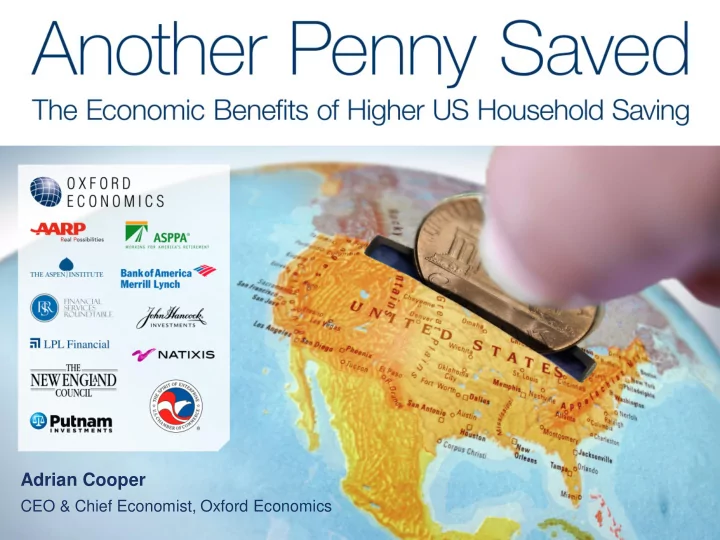

Adrian Cooper CEO & Chief Economist, Oxford Economics
The savings challenge
Key research questions 1. Assessing saving rates at the household level How big is the US household saving gap, across both income and age groups? 2. Is there a macroeconomic investment gap? What hazards face an economy in which investment capital is supplied increasingly by foreign investors rather than by domestic household savings? 3. Measuring the impact of increased saving What are the benefits to households and the economy of achieving a higher-growth path in which both saving and investment go up? 4. Paths to improving US saving How can government, employers, and financial-services providers incentivize households to save more?
How big is the household saving gap?
Many households at risk of undersaving for retirement
Post-recession, more households are at risk
How will a recovery in investment be financed?
US potentially increasingly dependent on foreign borrowing…
…paying higher interest, profits, and dividends to foreign investors
What would be the optimal household saving rate?
The economic benefits of higher saving
Increasing access to workplace savings plans is critical
The importance of savings incentives Once a workplace plan is established, employees must be encouraged to take it up through a combination of: • Nudges — not so much incentives as suggestions that require the worker to take specific action, but do not offer a financial reward. • Passive incentives that set default options that encourage the individual to save unless she specifically opts out — e.g., automatic enrollment, auto-escalation. • Active incentives — critical to encouraging plan sponsorship by small employers. These can be combined to create a saving framework that provides adequate retirement income — with automatic participation, steadily growing contributions, and a long-term, consistent investment strategy.
From debt to saving — key strategies • Achieving a pro-saving, pro-growth policy within a private sector system will require government, employers, and financial-services providers to work together. • Public policy should never pit personal solvency and national solvency against each other in a misguided quest for fiscal savings. • Existing saving incentives and vehicles should be preserved, improved, and extended to maximize saving. • The success of workplace payroll saving plans should be recognized as the prime driver of asset accumulation for working Americans. • Working households have a role to play in this process as well.
Recommend
More recommend